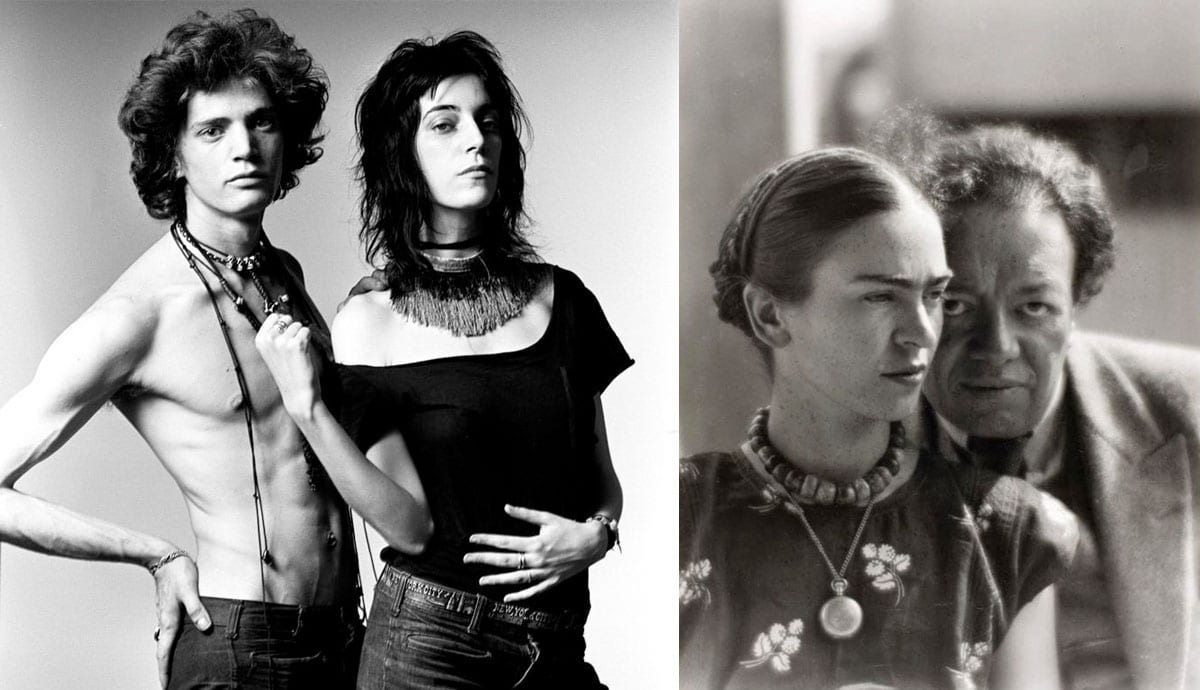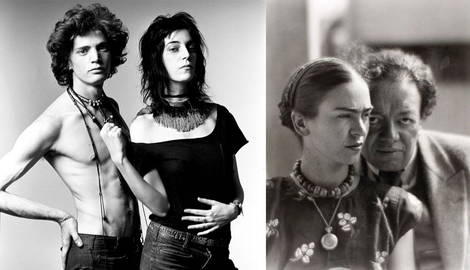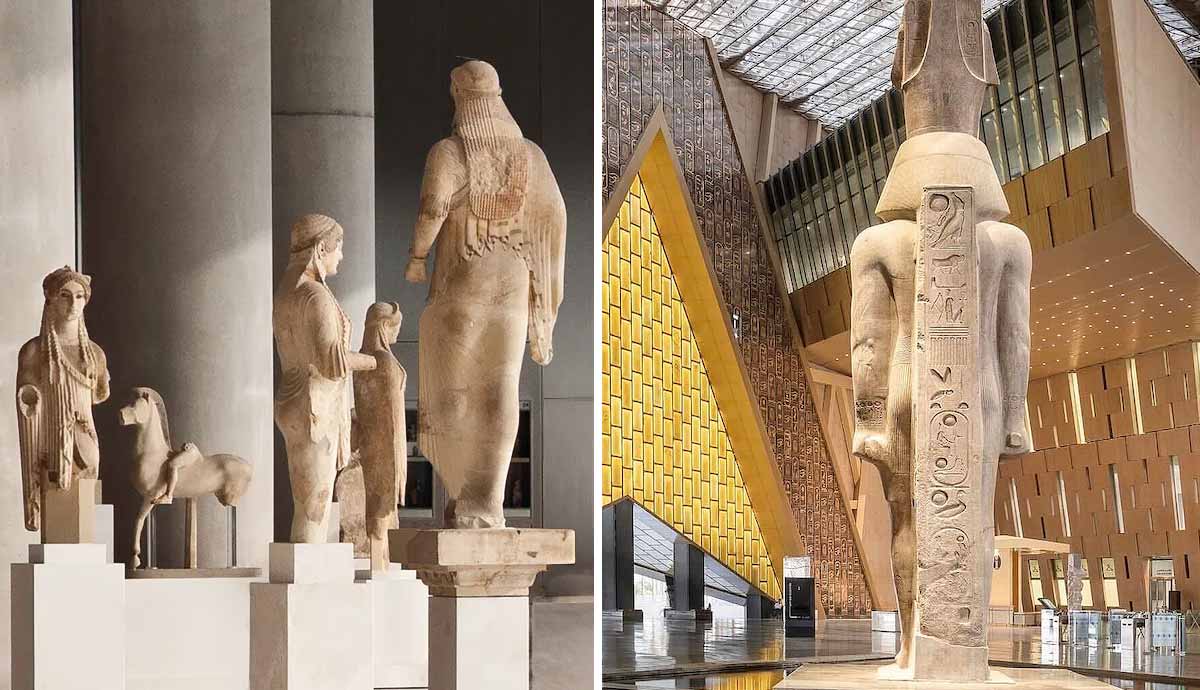f

Famous artists are often eclectic and captivating individuals. They often spend time with fellow creatives, building close friendships, and sometimes romantic relationships. Due to the strong personalities of each individual, these romantic relationships are often highly creative and collaborative but run the risk of becoming chaotic and destructive. Read more about the careers and personal lives of some of the most famous couples in art history.
Diego Rivera & Frida Kahlo: The Chaotic Love Of A Famous Art Couple

Frida Kahlo and Diego Rivera were both acclaimed Mexican artists and the duo remains one of the most famous couples of art history. Rivera was a prominent muralist and Kahlo was a renowned Surrealist painter. The pair met when Kahlo was in art school and Rivera was already an established artist. He was twenty years her senior. While Kahlo was hoping Rivera would become her mentor, the two became romantically involved, eventually marrying in 1929. Kahlo’s family did not approve of the union, nicknaming the pair ‘the elephant and the dove.’
Their relationship was tumultuous, characterized by a mixture of mutual creative reverence and romantic infidelity. Kahlo notoriously had an affair with Soviet revolutionary Leon Trotsky while she and Rivera were providing him political asylum in their home. While both parties engaged in extramarital affairs, Rivera hurt Kahlo deeply when he pursued her sister. This led the couple to divorce in 1940, only then to remarry in 1941. They then remained together for the rest of Kahlo’s life.

The pair was highly political and remained consistently outspoken about their support for the Communist Party. This both united them and caused significant stress. The political aspect of Rivera and Kahlo’s lives fuelled radical artwork elucidating the experiences of Mexican laborers and political refugees during the time. It also furnished Kahlo’s artistic career, as her bold politics bound her with André Breton and the European Surrealists.
Françoise Gilot & Pablo Picasso: An Emotionally Unstable Relationship

Pablo Picasso is known for his problematic romantic relationships, leaving some of his lovers emotionally disturbed after their parting. The pair met when Gilot was 21 years old and Picasso was 61. Picasso was living with fellow artist Dora Maar at the time, whom he left for Gilot. Though their relationship was originally between a student and mentor, it became a passionate love affair. Gilot was well aware of Picasso’s abusive romantic past and was cautious of falling into the same trap as his previous lovers
The famous couple spent 10 years together and had two children. Gilot set her own career aside and supported Picasso in his experimentation with new mediums including sculpture and ceramics. However, due to Picasso’s continuous philandering and her own creative discontent, Gilot left her husband. Picasso then condemned Gilot from an independent career, telling dealers not to sell any of her artwork.
Gilot eventually married the inventor of the polio vaccine, Jonas Salk. She then published her novel Life With Picasso in 1964, which elucidated her experience with Picasso in a particularly unflattering light. Her book claims that he was an emotionally abusive partner, despite his artistic genius.
Patti Smith & Robert Mapplethorpe: From Rags to Riches

In 1967, singer and poet Patti Smith moved from her small, Midwestern town to New York City. Smith quickly met another aspiring artist named Robert Mapplethorpe. They became lovers and moved in together soon after. The famous couple’s relationship has been romanticized ever since.
Smith often modeled for Mapplethorpe. He was the photographer for Smith’s famous album Horses (1975), which grew to immense popularity. This image solidified her bohemian aesthetic that has since defined her career. Mapplethorpe also photographed the cover of her return album Waves (1988), which was released after a decade-long hiatus. By this time, Smith was in love with a musician named Fred “Sonic” Smith and was beginning her life with him.
Though their relationship did not last forever, Smith and Mapplethorpe were integral to the development of each other’s artistic careers. Their collaboration helped each party reach iconic status. Smith later wrote the forward for Mapplethorpe’s final artistic work, Flowers.
Alfred Stieglitz & Georgia O’Keeffe: An Evolving Love

Georgia O’Keeffe and Alfred Stieglitz met in 1916. At the time, Stieglitz was 52 years old and already a renowned photographer, while O’Keeffe was only 28 and at the beginning of her career. Stieglitz became her mentor and exhibited her work, kick-starting her into fame. O’Keeffe eventually moved to New York City and lived with Stieglitz and they were married in 1924.
The pair was defined by their mutual creativity and respect for each other as each of their careers grew separately. However, their marriage was fraught with personal difficulties.
O’Keeffe wanted a child, but Stieglitz did not. She also felt stifled living with his family. As their relationship became increasingly strained, O’Keeffe decided to move alone to New Mexico to focus on her creativity.
It is in New Mexico where O’Keeffe found her true artistic calling and flourished. Though Stieglitz was devastated at the thought of losing his wife to her new life and career, the famous couple adapted to the new situation and remained together until his death in 1946. Their entire relationship is recorded in over 25,000 letters that the couple shared between 1915-1946, which outlined their growth from casual friends to lifelong partners.
DabsMyla: One Unified Pair

Dabs & Myla are both a famous couple and artistic duo. They are from Melbourne, Australia and they moved to Los Angeles in 2009. The pair met while studying illustration in Australia, becoming a collaborative artistic pair and later a couple. They create whimsical works reminiscent of street art/graffiti and the POP Art movement.
Their work focuses on larger, public art formats like murals and interactive exhibitions. The couple works both at home and in their interactive scenes. They constantly shift between being still and in-transit to locations such as London, Rio de Janeiro and Norway, where they have exhibited works. They have worked with brands like Adidas and Sanrio and they were included in Beyond The Street’s Top 10 Must-See Artworks. A critic said that “in their imaginative works, the world of DabsMyla continues to grow.”
The pair claims to be the happiest married couple on earth, claiming they never argue and live carefree lives. All of their art is a conglomerate of each party’s artistic ideas. Dabs contributes graffiti-inspired, fantastical creatures while Myla brings the element of photorealism and precision. They claim 100% joint effort on every work, both shouldering any artistic criticism or praise. Their collaborative cooperation sets an excellent example for all romantic and artistic partners.
Sophie Taeuber & Jean (Hans) Arp: Slaves To Their Art

Sophie Taeuber and Jean (Hans) Arp met in Zürich in 1915 at an exhibition that was featuring Arp’s work. Their relationship began with artistic collaboration, including geometric collages and sculptures made of wood. Their connection grew into a deep romantic love until they ultimately married. This art couple became members of Das Neue Leben (The New Life) artists association and continued to produce artwork both collaboratively and separately. Arp then founded the Dada movement alongside Max Ernst and Johannes Baargeld.
Both Arp and Taeuber enjoyed professional success in Paris. Arp became a prominent member of the French Surrealist group, and Taeuber continued to work in set and interior design whilst expanding on her geometric grid-style work. She also exhibited her tapestries in the United States. The pair also experimented with poetry, magazine writing and other art mediums, producing numerous joint sculptures.
By 1926, the pair became French citizens and moved to Strasbourg. Taeuber and Arp split their time between Strasbourg and Paris because Taeuber often received interior design jobs in Paris. However, the pair had to flee Paris due to German military occupation during World War II. Taeuber then died of carbon monoxide poisoning in 1943.
Despite the pair’s individual and collaborative success, Taeuber’s recognition as an artist has been consistently overshadowed by her husband’s. However, over time she has received more credit in both interior design and her contribution to modernism. Her and Arp remain integral members of the 20th-century avant-garde.
Gabrielle Münter and Wassily Kandinsky

Gabriele Münter met Wassily Kandinsky while studying at the Phalanx art school in Munich, Germany. Kandinsky was the school’s director but the two connected regardless. Because Kandinsky was married, he and Münter took a trip together soon after meeting and their love blossomed while away. In 1903, the pair became engaged and Kandinsky moved into Münter’s house.
During this period, Kandinsky’s post-impressionistic art flourished and he continued to experiment with artistic abstraction. He and Münter became partners on the front line of the Avant-Garde movement, though Münter did not venture as far into the world of abstraction. She scrutinized its importance more while Kandinsky embraced it fully. Kandinsky divorced his wife in 1911, but did not marry Münter. Instead, he left her in Zurich while he escaped to Moscow during World War II. He instead married another woman and the pair never reunited.
Münter was often considered his student-lover as opposed to an artistic equal. She has said that “in the eyes of many, I was only a side dish to Kandinsky.” Although she was integral to many of his projects like founding the Der Blaue Reiter expressionist group, Münter is never credited.
Robert Rauschenberg & Jasper Johns: A Forbidden Romance

Jasper Johns and Robert Rauschenberg were visual artists who had a romantic relationship throughout the 1950s. At this time, homosexuality was seen as an immoral threat to American society. To hide his homosexuality, Rauschenberg married a woman. However, the pair spent significant time together in a small New York City studio. Rauschenberg was older than Johns and often a mentor for the younger artist. He was the reason Johns was originally discovered by the major art dealer Leo Castelli.
Despite their different ages, the pair’s collaboration led to the downfall of abstract expressionism. Their work, including Rauschenberg’s Combines series (1954) and Johns’ Flag (1954) utilized ‘lowbrow’ art influences and everyday objects. This style became the predecessor to the POP Art movement.
While extremely productive, Rauschenberg and Johns’ relationship did not last. While Rauschenberg was originally Johns’ mentor, Johns’ career surpassed Rauschenberg’s, leading to significant competition and jealousy. By the early 1960’s their relationship fell apart. The pair did not speak for years after the bitter break.
Max Ernst & Dorothea Tanning: A Complicated Beginning

Max Ernst first met Dorothea Tanning at a party in 1942. At the time, Ernst was married to Peggy Guggenheim. Guggenheim was working on Exhibition by 31 Women for the Guggenheim Museum and sent Ernst to Tanning’s studio to view her work for this exhibition. Tanning’s self-portrait Birthday grabbed Ernst’s heart immediately. The pair then spent more time together and fell in love over a game of chess. Ernst eventually divorced his wife in order to be with the younger artist.
The pair moved in together, but eventually had to leave their Arizona home and move back to France, because Ernst was faced with American citizenship issues. The pair was highly collaborative, continuing to make work together throughout their careers. They still remained together until Ernst passed in 1976, seemingly still in love.
Between the shared notoriety of the famous couple, Tanning was often overlooked as an artist. Although her work was integral to the early 20th-century avant-garde, her art was only considered in connection with Ernst. It is only recently that she has received due recognition as an independent artist and contributor to modernism.
Emmy Hennings & Hugo Ball: Famous Art Couple And Founders Of Dada

Emmy Hennings and Hugo Ball met in Munich in 1915. Shortly after, the pair fled Germany to Zurich to avoid World War I turmoil. Once in Switzerland, Hennings and Zurich opened The Cabaret Voltaire. This experimental performance space became the epicenter of the Dada movement. Hennings and Ball performed each other’s poems and choreography on its stage.
The pair’s joint disenchantment towards the War, nationalism and societal restriction formed both the foundation for the Cabaret Voltaire and the Dada movement. The Cabaret Voltaire fittingly continued to feature bizarre and revolutionary performances. This drew a number of young, avant-garde artists who supported anarchy, radical leftism, and political freedom.
Ball left Zurich and met Tristan Tzara, who also became a founding member of Dadaism and a writer of the Dada manifesto. The anti-establishment attitude of Ball, Hennings and their contemporaries became a significant influence on 20th-century modern art.
Hugo Ball and Emmy Hennings are now known as the mother and father of Dada. The famous couple was extremely influential and prompted the movement together. The pair was eclectic, passionate, and always pushing the lines and rules of art. However, historically, Hennings is only really discussed in relation to Ball. Even though she and Ball worked collaboratively, Hennings has yet to receive due credit as an independent artist and revolutionary.










